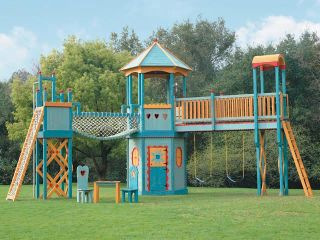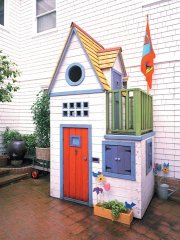Playtime Hits the Big Time
The Washington Post
Spring 2002
By Julie Dear
Washington Post Staff Writer
For Barbara Butler, playhouses are serious business. Drawing on her own childhood growing up with seven brothers and sisters, the San Francisco-based designer and builder creates whimsical confections worthy of the most active imagination: trapdoors, jail bars, swinging ropes, peepholes, escape hatches, fireman's poles. All that creativity doesn't come cheap, but Hollywood, design magazines and a growing number of people across the country have added their names to a waiting list of clients eager to play.
For five years, David & Marcia Kaplan of Bethesda, MD held onto a picture of one of Butler's houses torn from a 1995 Architectural Digest. This spring, their back yard became home to a 16-foot-high "play-castle".
"It's not just a kid's zone anymore," says Butler, whose work was featured in the Robin Williams movie "Bicentennial Man." "It is where the future is--so the whole family can have fun together."
The Kaplans agree. "We saw this picture before the house was even built," says Marcia Kaplan, a lawyer in the District. Once their stone and cedar-shingle house was finished last summer, they contacted Butler about adding a backyard fantasy playhouse for their four children. The older boys, Zack, 14, and Dan, 11, were delighted that their years of lobbying were paying off. Six-year-old twins Samantha and Jack chimed in with ideas about what features and colors to include. The result is Fort Bethesda, a 25 1/2-foot-long, two story play space built of redwood stained forest green and bright yellow with cedar doors stained red.
Playhouses are "not just for kids' zone anymore"

A seven-foot-square tower topped witha peaked roof has a shuttered window in front, a window with jail bars ("One of our most popular options," Butler says. "Kids are really into the jail theme."), a tiny escape door in the back, a ladder under a sliding trap door, and a mailbox for "love notes or secret messages." Each arched door has a sliding peek window that Butler calls a "who goes there."
Climbing over and through the structure offers a maze of possibilities. "There are easy ways up and hard ways up," says Butler, "but quick ways down."
One of the hard ways up is a side wall pocked with handholds and toeholds. "We order the stones from a rock-climbing magazine," Butler says. "They can be positioned with the indentations facing up for easy gripping or down to raise the difficulty." To get back to the ground, choose theblue tube slide or the stainless steelfireman's pole. A walkway above the swings leads to a second tower, a four-foot-square fort with a brass-knockered door and a rope net attached to a parapet above. There's a working flagpole with three flags-- a pirates' skull and crossbones, the Scottish lion victory flag "and the white flag of surrender, just in case."
The belt swings are designed with heavy-duty chains and hardware rated for up to 300 pounds. "Even as they get older," Butler says, "the swings are where they come back to, to sit and swing. Swings are where serious conversations happen."
The Kaplan children added another idea, says Butler. "A dumbwaiter up to the top floor, so we put in a pulley line and bucket, so the twins' request for drinks up top would be easy."
Butler says her designs draw on childhood memories of growing up in a big family in Upstate New York. "We had a terrific rope swing in an old tree. And two metal bars at different heights, like chin-up bars. There was a three-foot-high rock wall around part of the house that we could pretend was a ledge next to a lava pit when we were learning to climb."
She started out studying political science in college ("my mother wanted me to be a lawyer"), but after graduation learned bricklaying and construction from an older brother, James, who was a contractor renovating houses on Capitol Hill. After an intermission in graduate school, she moved to San Francisco in 1983 and started a company called Outer Space Designs with a friend. "We specialized in decks, hot tubs and fences but did not even think of play structures."
Singer-songwriter Bobby McFerrin hired the duo to build an elaborate deck, and his wife, Debbie, asked for a playhouse. "Once I had done one, another couple saw it and become interested, and it just started snowballing from there."
Her company, Barbara Butler Artist -Builder Inc., is co-owned with her sister Suzanne Butler, and her husband Jeff Beal, who grew up in Potomac. The firm has grown to 13 employees and usually has about eight projects going at once. Her work was included in "The Treehouse Book" by Peter and Judy Nelson with David Larkin published in June (Universe, 224 pp., $25). She displays her designs at garden shows across the country, including Washington, Richmond, and Charlotte, and on her website, www.barbarabutler.com. "I watch what the children play on during the shows," she says, "and it gives me more ideas."
Butler's play structures range from portable models starting at $2,400 to custom fantasy spaces in the $16,000 plus range. The Kaplan's spent about $40,000. While Butler agrees that's a lot to spend on a playhouse, she points out that it's often less than building a family-room addition. Plus, "it gets people into an outdoor room, in their yard, and being active together."
At a recent garden show in Santa Monica, Calif., actors Jada Pinkett Smith and Will Smith picked out an intricately carved and painted Storybook cottage for a house they are building in Los Angeles.
The Cape Codder has three levels. 